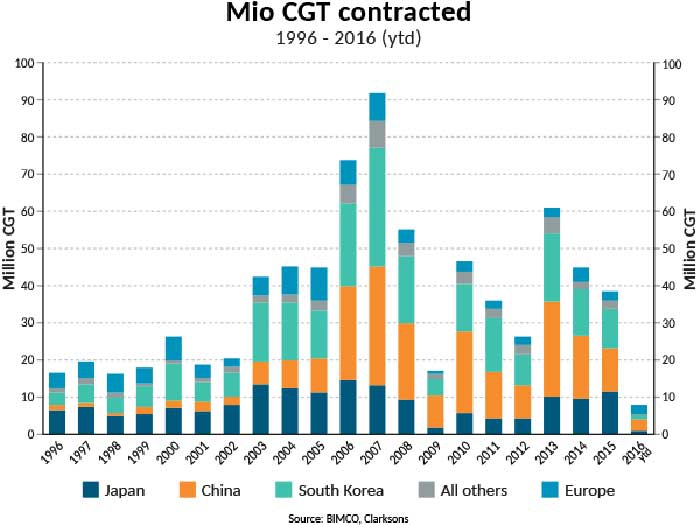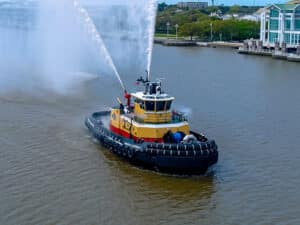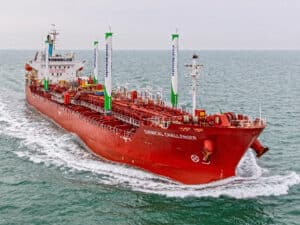
BIMCO: Shipbuilding orders at 20 year low
Written by Nick Blenkey
SEPTEMBER 14, 2016 — BIMCO says that shipyards are falling victim to deteriorating conditions in the dry bulk, container and offshore markets, with 2016 looking to set the record for the lowest newbuilding contracts in more than 20 years.
After a decline from 2010 to 2012, shipbuilding had a rebound in 2013 and was expected to level out over the next few years. The reality was a slight decline in 2014 and 2015, though there were still high levels of contracting in compensated gross tonnage (CGT terms).
Since then, shipyards have crashed, as the contracted CGT globally has plunged.
“Since the high contracting in 2013, BIMCO expected the shipyards could come under pressure,” says Peter Sand, Chief Shipping Analyst at BIMCO. “This expectation became a reality at the start of 2016, with Q1 contracting the second lowest CGT in 20 years.”
Mr. Sand says, though, that a low level of shipbuilding contracting is “exactly what the shipping industry needs in order to eventually restore the fundamental balance between supply and demand.”
Japanese and South Korean contracts down by 86%
Shipyards in Europe were the only ones to see an increase in contracting in the first eight months of 2016 compared to the same period in 2015. Europe contracted 2.52 million CGT, an increase of 45.3% compared to the previous year.
Japan and South Korea have had the biggest decline in contracting, down by 86.7% and 86.5% respectively, compared to the same months the year before. China contracted 49% less CGT in that period.
Globally, the tanker and container segments are the main reasons for diminishing new orders, by percentage as well as in CGT, in 2016. Combined, they were responsible for 67.7% of the total contracted CGT in the first 8 months of 2015. This year, tanker contracts are down by 80.1% and container contracts are down 84.1% compared to the same eight months last year.
Alarming order cover due to overcapacity at the shipyards
The effect of declining contracts and continuing shipyard overcapacity has put pressure on the shipyards order cover. The order cover is the number of years it will take to deliver the scheduled order book, based on the capacity of the shipyards. It is calculated by the size of the shipyards current order book over the previous year’s average monthly output.
Shipbuilding in South Korea is suffering the most, as Korean yards hold orders for less than two years of building. Europe continues the positive trend seen in contracted CGT, with increasing order cover. This shows that additional contracting orders are not being absorbed by new shipyards entering the market.
Peter Sand comments: “There is a declining trend for Japan, China and South Korea and with such low levels of newbuilding contracts being placed, this will look even more severe next year. However, the order cover could have been even lower, if capacity had been taken out due to shipyards cutting down on operations or closing entirely”.
Troubles for South Korean shipyards started in 2014
South Korea saw it order cover start to decrease from 2014 to 2015, whereas China and Japan saw the decline one and two years later respectively. This might be an indication of South Korean capacity being held artificially alive by government support — something seen in many places in the shipping industry.
Though Europe’s order cover is still increasing and is currently 5.3 years, Europe is only responsible for 9.3% of the global order book, with its orders consisting mainly of ferries, tugs and cruise ships.
As 67.9% of the Chinese order book and 58.4% of the Japanese order book are deliveries for either the container, dry bulk or offshore segments, there is a possibility for postponements and cancelations. The postponements can add a further headache to the shipyards’ liquidity, as the final payments in these cases may be delayed.





Leave a Reply
You must be logged in to post a comment.